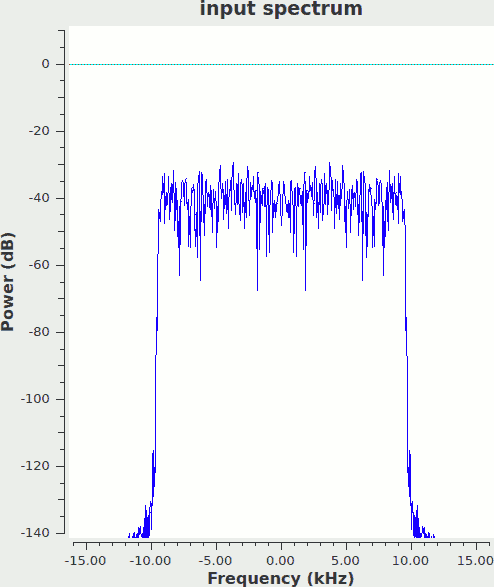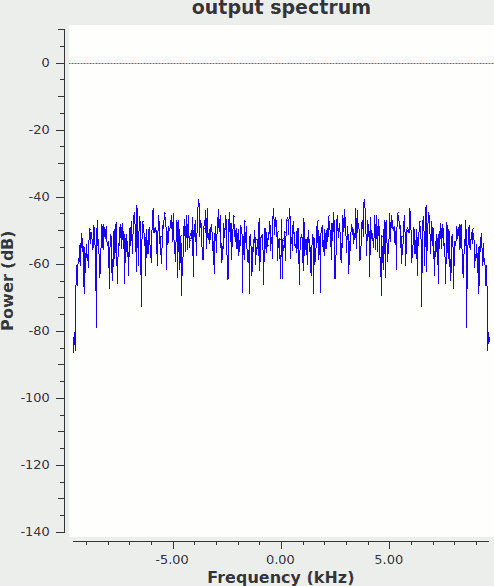Was I supposed to know somehow that the rational resampler includes the necessary aliasing filters? That's not meant to be a sarcastic question - I'm trying to figure out where to look in the documentation for these sorts of things.I think it's actually a good question! It's always better to ask how you can figure out something rather then just relying on pre-made solutions.
I don't have GRC to hand, but I don't remember it being in the documentation for the block.GRC docs typically only contain a small piece of the information in the full doxygen.
So the point here is that the doxygen [1] does mention it builds a rational resampling polyphase FIR out of the taps that you need to supply.
Also, it quite explicitely says that you need to use a filter that will suppress the aliases or images (depending on what's higher, decimation or interpolation).
So the thing that's happening here is that you want to achieve a M/N resampling; you actually[2] do the following:
--->[↑ M] --> [↓ N] -->
So you pad 1 input sample to M "intermediate" samples by simply adding M-1 zeros after each sample, and then you throw away N-1 out N samples.
Simple as that? Not really. First of all, as you've noticed, the M interpolation introduces aliases.
So assume the input spectrum might look like this:

Obviously, we're wasting sample space here. So having a sharp look, we determine that this only needs 3/5 of the original bandwidth; hence M=3, N=5.
What we want to have looks like:

I.e. we want spectrum that as closely fits the full Nyquist bandwidth, but doesn't "overlap" the edges, ie. there's no aliasing at the edges. Notice that at the band edges, the spectral power goes down by > 20dB.
What we actually get if we just interpolate and decimate (GRC file here [3]) however looks like

The output spectrum is a obviously continuous piece of overlaid signal; if you look closely, you'll notice that these two center peaks seem to re-appear at ~+-7kHz. Something is wrong here.
But it's not really surprising: If you take a look at the intermediate spectrum [4], there's the 3 repetitions we'd expect from interpolation. Now, mentally cut the intermediate spectrum in five equally wide parts, and mentally shift them the four outer ones over the center one. That aliasing is what ruins our signal!
That demonstrates what's necessary to get rid of this: in the intermediate spectrum, we'll need to suppress everything that isn't in the "middle" zone. Doing that yields [5], which is what we wanted.
Here, M < N, and that's why you need an anti-alias filter; but the same M repetitions appear for any M, and the same "cut up and overlay" logic applies to any N; this explains why for M > N, you need an anti-imaging filter.
The point here is, though, that you just really need one filter here, and it needs to be the stricter one of both (cutoff at decimation/interpolation or at interpolation/decimation). Of course, if you follow up with another filter that already fulfills that, you might as well just interpolate that filter to match the M*input sample rate, and use that. Due to [2], rational resamplers don't actually run at M*input sample rate (that would be computationally terrible!), so the resulting filter might actually be not much worse than the minimal filter that you'd use just to guarantee proper resampling, but you might just save a whole separate filter.
Best regards,
Marcus
[1] https://gnuradio.org/doc/doxygen/classgr_1_1filter_1_1rational__resampler__base__fff.html#details
[2] Note that there's polyphase trickery that mathematically does the same as just actually adding the zeros, and throwing away samples, but without doing the unnecessary operations (who needs samples that get thrown away? Who needs to multiply something with 0 to then add it up?)
[3] https://gist.github.com/marcusmueller/24d64e67709fafbf036f#file-spec-grc
[4] https://gist.github.com/marcusmueller/24d64e67709fafbf036f#file-nofilter-png
[5] https://gist.github.com/marcusmueller/24d64e67709fafbf036f#file-proper-png
On 10.08.2015 11:06, Tom Cook wrote:
Many thanks to all who responded here. As Martin remembered faintly, the RTL-SDR dongle does not work well at low sample rates, and it gives considerably better reception to run it at (eg) 1.536 Msps and then resample it to 384 ksps than to use 384 ksps from the start.
Thanks to Tom for pointing out the ways of combining resampling and filtering. Was I supposed to know somehow that the rational resampler includes the necessary aliasing filters? That's not meant to be a sarcastic question - I'm trying to figure out where to look in the documentation for these sorts of things. I don't have GRC to hand, but I don't remember it being in the documentation for the block. The documentation for the rational_resampler_base_fff class sort of hints at it without saying as much, and it took me quite a while to figure out where to find even that.
At any rate, I've got the thing running in realtime, and performing quite well after replacing the crummy antenna provided with the dongle with a VHF TV antenna pointed in the right direction.
Thanks again,Tom
_______________________________________________ Discuss-gnuradio mailing list address@hidden https://lists.gnu.org/mailman/listinfo/discuss-gnuradio